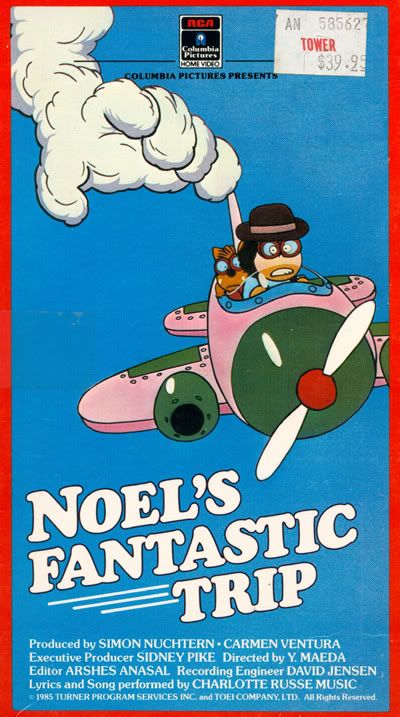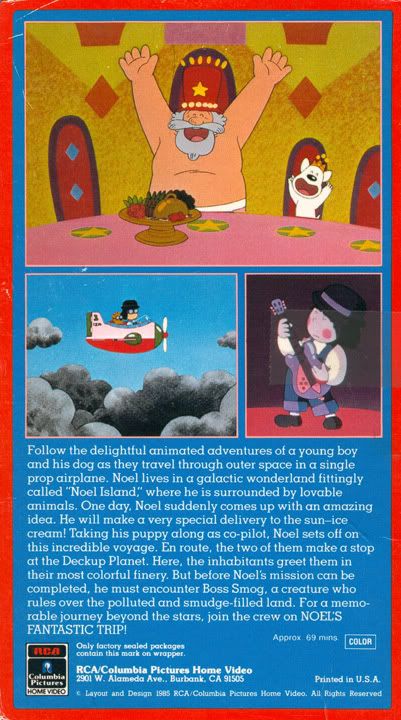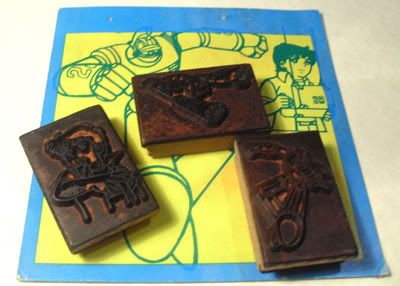
No, I did not pay $39.95 for this.
Most of us get obsessed with Japanese cartoons as children, and it's only later that we start to realize part of what attracted us to the things is that they are, at least to Western eyes, really strange. I mean, seriously; when you're a kid you just accept the fact that people might dress up in bird costumes and fight giant mummy robots, or that a World War Two battleship would naturally make a great intergalactic weapons platform. As adults, however, you take a step back and say, "wait a minute..."
I encountered NOEL'S FANTASTIC TRIP as an adult, so I have no childhood confusion about its narrative coherence-- there is none. This film makes absolutely no freaking sense what-so-ever. Equal parts fairy tale, antipollution message, and multicolored hallucinogenic experience, it's a movie that defies rationality, copyright, and traditional notions of "entertainment" and "common sense".
It's about a little girl named Noel. The box copy describes Noel as a boy, but Noel is addressed as "miss" in the film, and the character is introduced singing a daydream song about living life as a country girl, making it clear that whoever greenlit this video release at Columbia hadn't bothered to sit through five minutes.

Noel's Holly Hobby obsession brought to life
Anyway, Noel lives on a floating island along with a zoo's worth of friendly animals. One day while relaxing in the sun after singing a song about wanting to be a country girl, Noel decides the Sun might like some ice cream. So, Noel and her little dog pal Pup take off in their airplane to deliver ice cream to the Sun. Now you might think,a movie about a girl living on an island floating in the sky piloting an airplane to the Sun while playing Good Humor Man, that's kind of out there. Well, just wait, this is the NORMAL part.

Once out of Earth's atmosphere, Noel encounters the Space Shuttle, a 2001 style ring space station, and in some sort of fanfic writer dream scenario, is passed by the Space Cruiser Yamato, or at least a reasonable facsimilie thereof.

We're off to outer space all right.
There's an extended musical number involving stars and asteroids and comets and outer space in general. Next stop is the Planet Gaudy, a glammed out place where everybody dresses as outlandishly as possible until Noel convinces the citizens to take all their clothes off. Leaving a planet of nudists in their wake, Noel and pal reach the Sun, whose enjoyment of ice cream is only slightly marred by a bit of smog drifing in from some unknown planet.

Can Noel find the source of pollution and convince them to enact pollution controls? Diving underwater to escape the billowing clouds and belt out yet another song, Noel's subsea spotlit rock guitar solo is interrupted by the Beatles, complete with Yellow Submarine.

Oh, you thought we were kidding?
After a couple of songs the journey continues, interrupted only by another song, and a smog attack. I guess the smog is tired of the incessant singing too. Who can save Noel now? Super Zoomer, of course! Super Zoomer, a whale in a Superman suit who's a student at the Superman school and can change the course of mighty rivers and bend steel in his bare hands! He answers Noel's SOS and soon his mighty super whale powers have saved the day.

Super Zoomer and the Super School
On the horizon they spot the smog's source, a giant city full of factories spewing out pollution. And songs, also about pollution. Apparently this city, populated by foxes and bunnies and bears, was once nice and sunny, but when the factories came and people started driving smelly cars the air got bad and people got sick all the time. Explained through song, the conflicts of the industrialized world - things we like produced in factories that destroy the land and air - seem very simple, especially when set to music and illustrated with scenes of anthropomorphic animal children playing in aquaducts and junkyards.
Luckily in the cartoon world the problems of industrial pollution can be solved by hollering for Super Zoomer to come and battle a giant talking pollution cloud. Blue skies return to the animal city after Super Zoomer uses his super lung power to blow the pollution far away, where it becomes somebody else's problem. This allegorical battle between a talking super whale and a talking smog cloud seems downright normal compared to the next sequence, which is a musical production involving legions of tricycle riding babies pedalling in aerial formation from the time of the dinosaurs to the present. I repeat, tricycle riding flying babies.

Nothing a choreographed platoon of babies can't solve.
The song is all about how the world is better now that cars are running on "good gasoline" and how we've saved the world through "clean energy". Is there a better way to promote catalytic converters and antipollution regulation in general? And... that's the movie. Feeding the sun ice cream, meeting the Beatles, calling a giant whale to fight pollution.
At a mere 70 minutes you'd think the film would zip past, but you'd be wrong. Most of the movie is songs, tedious songs. And while the musical numbers are full of colorful, psychedelic quasi-mod graphics, only children small enough to be transfixed by any colored moving shapes will find it entertaining. Those of us older than 4 will be scratching their heads in confusion at this, seemingly a film intended for babies, immigrants, and guys on mushrooms.

NOEL'S FANTASTIC TRIP was produced by the mysterious IRUKA, as the film reminds us in a giant credit at the beginning. Who is IRUKA? Why would IRUKA produce a movie both tripped-out and dull? Research only gives us glimpses of IRUKA as some kind of Japanese music producer, which leads me to believe that NOEL'S FANTASTIC TRIP's primary purpose was to highlight some IRUKA musical production. Since much of the music was rerecorded for the American version I have no way of knowing whether IRUKA's enigmatic gamble paid off.

Apparently Noel was popular enough to sell candy. Image swiped from "the internet".
In America Turner Production Services got the job of localization, which means more work for Peter Fernandez and Corinne Orr, and the Grimes, Curtis, Hammond gang. As part of Columbia's mid 1980s catalog of Japanese animated films, it shares the mysterious "can't believe this is for kids" vibe of their Sanrio films UNICO IN THE ISLAND OF MAGIC and RINGING BELL, but rather than super wizardry or bleak Darwinism NOEL'S FANTASTIC TRIP can only give us the Beatles and super whales.

The film's not without appeal; the character designs have a charming children's book illustration feel and there's an aggressive whimsy in Noel's transforming house/airstrip, the super-school perched on a peak on a lonely asteroid, the Miffy-based animaltown residents. But when half the movie is taken up with mid-tempo musical numbers about stars or country girls or clean energy, you wind up boring older children, confusing adults, and making Apple's lawyers sit up and take notice.







